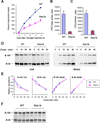Regulation of hepatic lipogenesis by the transcription factor XBP1
- PMID: 18556558
- PMCID: PMC3620093
- DOI: 10.1126/science.1158042
Regulation of hepatic lipogenesis by the transcription factor XBP1
Abstract
Dietary carbohydrates regulate hepatic lipogenesis by controlling the expression of critical enzymes in glycolytic and lipogenic pathways. We found that the transcription factor XBP1, a key regulator of the unfolded protein response, is required for the unrelated function of normal fatty acid synthesis in the liver. XBP1 protein expression in mice was elevated after feeding carbohydrates and corresponded with the induction of critical genes involved in fatty acid synthesis. Inducible, selective deletion of XBP1 in the liver resulted in marked hypocholesterolemia and hypotriglyceridemia, secondary to a decreased production of lipids from the liver. This phenotype was not accompanied by hepatic steatosis or compromise in protein secretory function. The identification of XBP1 as a regulator of lipogenesis has important implications for human dyslipidemias.
Figures




Comment in
-
Physiology. Unfolding lipid metabolism.Science. 2008 Jun 13;320(5882):1433-4. doi: 10.1126/science.1159651. Science. 2008. PMID: 18556540 Free PMC article. No abstract available.
References
Publication types
MeSH terms
Substances
Grants and funding
LinkOut - more resources
Full Text Sources
Other Literature Sources
Molecular Biology Databases

